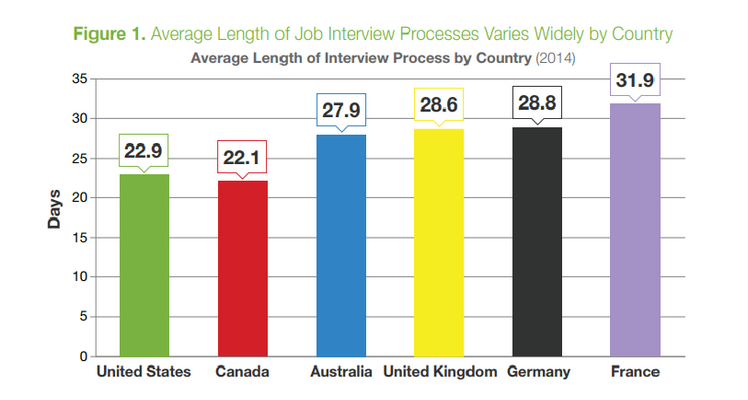Candidate dropout is when a person applies for a job, but during the process, the candidate no longer wants the position or has been hired elsewhere. This can be frustrating for the modern recruiter, and it’s a lot of wasted time.
How do you reduce the candidate dropout rate in recruitment? The short answer:
- Have a quick recruitment process
- Have a clear and precise job ad
- Take care of the candidate’s experience
- Have a good employer brand
Moreover, having a good pool of candidates, even if it does not reduce the dropout rate, allows you to limit the damage by having more choices. Let’s talk about it.
Ready? Let’s go.
Speed up the recruitment process to avoid abandonment
The average time for a recruitment in France is of course variable depending on the type of position and sector.
But according to a 2017 study by Glassdoor, France unfortunately took the cake for the longest recruitment processes in the world:
32 days
Compared to 23 in the US during the same period.

Scouring the web for statistics, one can find average times of up to 40 days. But here are the “worldwide” average figures determined by Workable by sector:
| Sector | Average time to hire (days worked) |
| Construction | 12.7 |
| Tourism and hotels | 20.7 |
| Retail | 24.6 |
| Transportation and storage | 24.9 |
| Professional services/consulting | 25.2 |
| Industry/Factory | 30.7 |
| Other services | 31.2 |
| Information | 33 |
| Community/public | 40.9 |
| Financial Services | 44.7 |
| Health care | 49 |
According to Officevibe statistics, the best candidates exit the market after 10 days.
If you have a high dropout rate, try to determine the time that elapsed between the first interaction with a candidate and your first response, subsequent exchanges, interviews…
According to the recruiting site Stepstone, on average, a job seeker will send out 40 applications before finding one. Don’t let my best candidates go to your competitors: speed up your recruitment process.
One of the first steps is to implement a powerful job posting and application management tool, like Jobaffinity.
You can also set up a questionnaire system so that the candidate can self-assess on different points, to greatly accelerate your sorting speed.
Of our many clients, about 60% use questionnaires to accompany applications. Each answer can be given a number of positive or negative points. Thus, in the application overview, you can see the score of each applicant at a glance.
Having a clear and precise job ad to avoid abandonment
We talk about this in great detail in this article on how to write a good job ad. But here’s a quick summary:
- Be clear and concise
- The position, its nature, its remuneration and the requirements are defined
- You start by talking about the candidate and your expectations
- You are precise in your essential needs without adding too many requests
- You highlight your employer brand without overdoing it
The clearer and more precise the ad, the more a candidate will know that he or she is made for this position, the more he or she will want to get it. But the number of job ads is exploding, you have to know how to be understood and identified immediately.
See our article for more details on the subject, a good job ad and the basis of a good recruitment.
A good follow-up of the candidate to keep him/her informed and avoid abandonment
You have to integrate the candidate into the recruitment process, not leave them in the dark, with no answer, no timeframe and no idea if their application has already been passed over, if it is being analyzed or if it has even been received.
According to a Stepstone study, more than 8 out of 10 candidates have never received a response from the companies they applied to.
You need to have a communication process in place, whether it’s automated or with a little human input (that’s even better). But you need to keep the candidate informed of the progress of their application.
Not just to tell them that their application has been accepted or that they have been invited to an interview! Here are some example steps for sending emails to candidates:
- Application well received
- Application under analysis
- The application is taken into account for the next step, the invitations for interviews will be made from [date] until [date] approximately
- Invitation to an interview
- Even if you have specified it during the interview: date of the end of the interviews
- Estimated date of decision
- Decision
This way, the candidate knows where they stand, they don’t need to follow up, they know what to expect. Of course, you have to meet the deadlines you set.
You’re going to tell me: I’m not going to send 7 emails per candidate, I have an average of 40 per ad! That would be almost 300 emails!
And you’re right, that’s why there are application tracking tools like Jobaffinity, so that with one click, you can trigger the sending of personalized email templates according to the status of the candidates, for one or several at a time.
This way, your candidates will know where they stand, and may decide to take a few more days before accepting an offer other than yours.
You send a positive image: you care about your candidates, you communicate, you keep them informed and you are organized. This speaks volumes about your company and how your employees are viewed.
Have a good employer brand
If certain deadlines are unavoidable, another thing will play in your favor: the candidate’s desire to work for you.
This is where your employer brand comes into play, which we will develop in more detail in this article.
The employer brand is the image you send as an employer, as a boss. Are your employees happy, trained, protected? Is your positioning clear and committed (solidarity, ecology, economy, innovation, inclusion…)? Are your internal communication processes good and fluid? How is onboarding going? What is the team spirit?
Employer branding may make some candidates wait, especially if they have already heard about you beforehand, either through the press or social networks, or because they have already used your products or services.
Employer brand is between marketing, communication, management and HR, it must be at the heart of your strategies.
Use a good recruitment software
According to a report by Deloitte, companies that use recruitment software accelerate the speed of recruitment by an average of 42%.
Multi-distribution of ads, monitoring of all resumes in one place at a glance, internal rating, consultation of managers, semantic or quality search, creation of questionnaires, automatic sending of emails or notifications to candidates and team members, resume pool, interconnection with HR tools…
Imagine how much time this can save. Do not hesitate to ask our consultants for a demo of our tool. They will be happy to show you all the advantages of Jobaffinity.
Having a good pool of candidates to reduce the impact of dropouts
Abandonment will always exist, there are many reasons why a candidate can abandon during the recruitment process: another offer that is more interesting or closer, another position that allows telecommuting, the other company seems to have a better employer brand, a competitor offers a job even before the first interview with you, personal reasons…
In order to avoid finding yourself in a bind, it is interesting to create a “pool” of candidates: profiles that correspond to your various needs that you can call upon when the time comes.
You are not only addressing job seekers who are not currently active: you can also target professionals who are already working, people who are currently self-employed, people who are doing an internship or finishing their studies…
Two points are therefore important:
- Aim for a wide audience (multi-posting of ads, social networks, etc.)
- Keep track of applications.
Keeping track of applications means having a good system for sorting, organizing and storing all the applications you may have had. If someone wasn’t right for this job three or four months ago, maybe this new position that’s opening up is perfect for them. Maybe their trial period in another job is not over or they are not happy with their current company: you can contact them again.
Jobaffinity’s features include one-click multicasting and a customized library of profiles and resumes with a search function.
Conclusion: there’s no point in running, but a bit anyway
As you can see, even though there are several important points to reduce candidate abandonment rates, the key point, the crucial point, is the most important one: reducing recruitment time.
The more you will optimize your recruitment with clearly established processes and digital tools to rely on, the less dropouts you will have (and the more you will avoid leaving the best profiles to your competitors).
The second most important point is to communicate with your candidates, not leave them in doubt. Whether you do it yourself or whether you implement automated or semi-automated solutions: you must communicate.
We hope that you will manage to reduce this dropout rate quickly, the job market is more and more complex, the recruiter’s job is changing, you have to keep up with the times!








